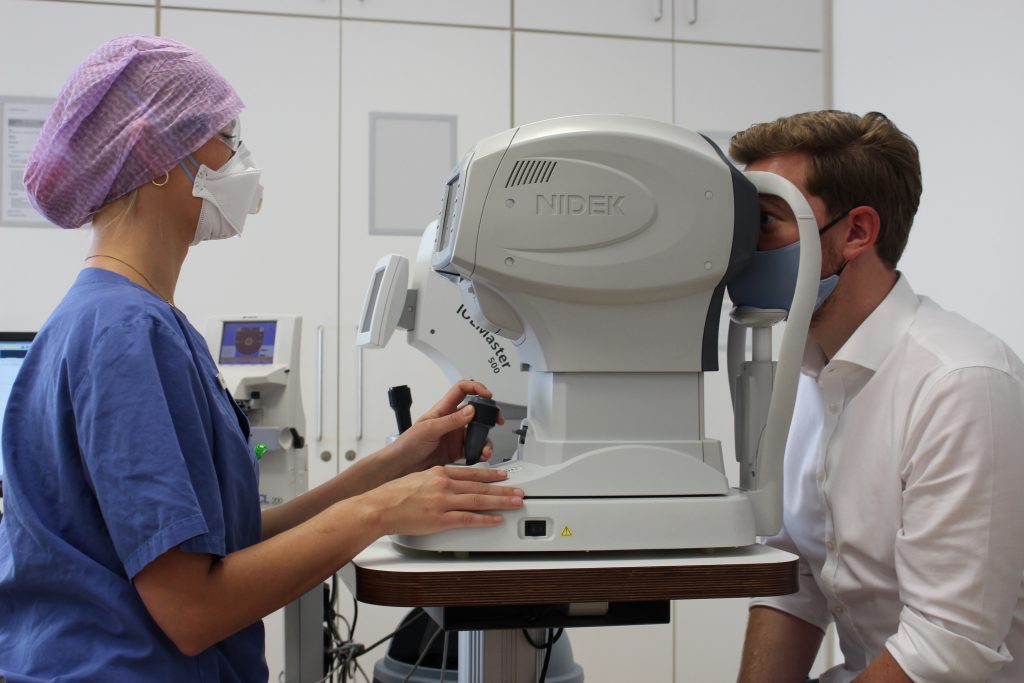Defining the risk of COVID-19 in Certain Standard-of-Care Diagnostic Tests

Omid Kermani
Published: Tuesday, July 7, 2020
 Omid Kermani MD
Omid Kermani MD On the other hand, non-contact tonometry, which utilises a puff of air to assess the pressure of the eye, is viewed suspiciously as it is assumed that the air puff will cause dispersal of the tear film. University of Hong Kong ophthalmologists indicated that they had suspended all tests that might result in micro-aerosol, including non-contact tonometry in a letter to the journal, Eye. However, the Glaucoma article authors contend that there is no set evidence that there is aerosol transmission with current devices and note that non-contact tonometry enables clinic staff to put more distance between themselves and patients.
Interestingly, a 30-year-old study on the alleged dangers of non-contact tonometers actually showed that the air puff did not produce any aerosol transmission from tears. In this study, researchers performed the air puff on eyes with a normal tear layer and then using a fluorescein-stained drop. When the air puff was administered after the drop, there was spraying of the fluid. However, when the air puff was administered to the natural tear layer, no droplets were found on nearby surfaces and there was no aerosol transmission.
Can safety rules make vision exams 100% safe?
Based on our review of literature and guidance, we think it’s clear that virus transmission can never be completely stopped. Wearing masks and safety glasses are good barriers against direct droplet transmission even within the proximity between patient and examiner. Gloves protect the examiner while touching the patient’s face and eye. But care must be taken to avoid cross-contamination of surfaces or other instruments, even when wearing gloves.
While there is a risk of viral transmission from the eye, aerosols with higher virus concentrations come from breathing or speaking. In our experience, these aerosols cannot be avoided completely even when both patient and doctor are wearing masks. This is indicated by the fact that glasses become steamed-up while the patient is wearing a mask. For this reason, distance between doctor and patient should reduce the risk. Most importantly, frequent ventilation is the best protection against potential infection by aerosols as the Robert-Koch Institution points out. The highest risk of infection with SARS-CoV-2 virus is given by direct droplet transmission or by fomites. The highest risk for these events is given by close doctor-patient contact over a longer period of time.
References on request
On the other hand, non-contact tonometry, which utilises a puff of air to assess the pressure of the eye, is viewed suspiciously as it is assumed that the air puff will cause dispersal of the tear film. University of Hong Kong ophthalmologists indicated that they had suspended all tests that might result in micro-aerosol, including non-contact tonometry in a letter to the journal, Eye. However, the Glaucoma article authors contend that there is no set evidence that there is aerosol transmission with current devices and note that non-contact tonometry enables clinic staff to put more distance between themselves and patients.
Interestingly, a 30-year-old study on the alleged dangers of non-contact tonometers actually showed that the air puff did not produce any aerosol transmission from tears. In this study, researchers performed the air puff on eyes with a normal tear layer and then using a fluorescein-stained drop. When the air puff was administered after the drop, there was spraying of the fluid. However, when the air puff was administered to the natural tear layer, no droplets were found on nearby surfaces and there was no aerosol transmission.
Can safety rules make vision exams 100% safe?
Based on our review of literature and guidance, we think it’s clear that virus transmission can never be completely stopped. Wearing masks and safety glasses are good barriers against direct droplet transmission even within the proximity between patient and examiner. Gloves protect the examiner while touching the patient’s face and eye. But care must be taken to avoid cross-contamination of surfaces or other instruments, even when wearing gloves.
While there is a risk of viral transmission from the eye, aerosols with higher virus concentrations come from breathing or speaking. In our experience, these aerosols cannot be avoided completely even when both patient and doctor are wearing masks. This is indicated by the fact that glasses become steamed-up while the patient is wearing a mask. For this reason, distance between doctor and patient should reduce the risk. Most importantly, frequent ventilation is the best protection against potential infection by aerosols as the Robert-Koch Institution points out. The highest risk of infection with SARS-CoV-2 virus is given by direct droplet transmission or by fomites. The highest risk for these events is given by close doctor-patient contact over a longer period of time.
References on request